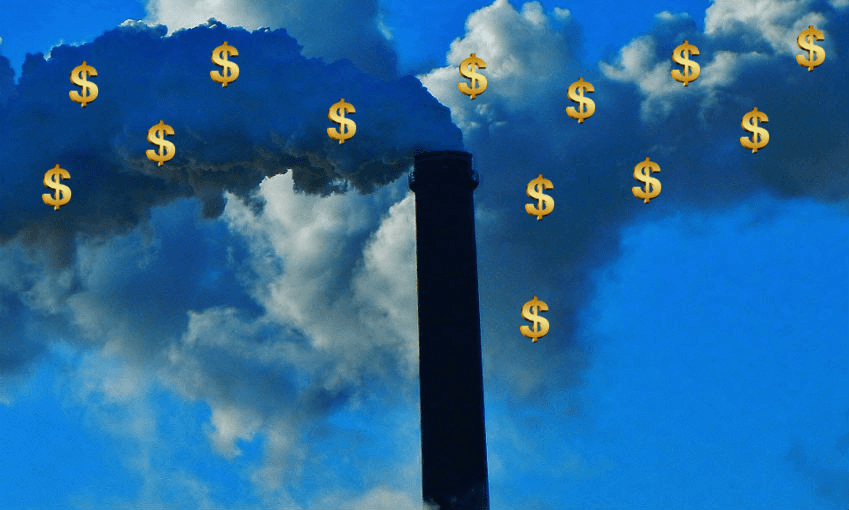Covering Climate Now: Charging businesses for their greenhouse gas emissions seems simple enough, but in New Zealand, at least, emissions keep on rising. Is the system flawed, or is it how we’re implementing it?
The Spinoff’s participation in Covering Climate Now is made possible thanks to Spinoff Members. Join us here!
Economists believe they’ve figured out the best way to tackle climate change and they did it way back in the 1970s. The idea is fairly simple: charge people for their greenhouse gas emissions.
If companies and individuals have to pay for the literal tonnes of gases they spew out, the argument goes, they’ll find clever ways to lower their carbon bill. On the other hand, people who find ways to absorb greenhouse gases (for example by planting trees) earn a pay cheque.
But exactly how that’s done differs radically from country to country and its effectiveness ranges from ambitious to participation-award status. Getting this economic concept to work in real life means governments need to grow a pair and people need to understand exactly what they’re paying for.
New Zealand’s version of carbon pricing is the Emissions Trading Scheme, ETS. Businesses pay the government for every metric tonne of carbon dioxide or other greenhouse gases emitted and foresters get paid by the government for their carbon-dioxide-absorbing trees. All this happens through a currency called New Zealand emissions units.
Individuals don’t pay for their emissions through an extra fuel tax, like they do in other countries such as Canada, Japan or France. Instead, the ETS assumes that the companies who import fossil fuels will pass their costs down to their customers.
We should be well on our way to solving climate change but, according to sustainable energy expert Ralph Sims, the ETS has done nothing to lower our emissions, which keep on rising. “It’s failed,” the Massey University professor emeritus says.
Here’s why.
New Zealand’s biggest emitter, the agriculture sector, has had a hall pass this entire time. So some 38 million tonnes per year of hot-house-inducing gas has gone unpaid.
Other businesses get off almost equally as unscathed by getting free credits from the government. Some get up to 90% of their emissions paid for and others around 60%. Their argument is that they’ll take their business overseas to countries without carbon pricing if they have to pay too much in New Zealand.
Second, businesses could previously buy the AliExpress version of emissions units from overseas. Where the Kiwi government would charge around $25 for one unit, countries like the Ukraine charged mere cents. Up until 2015, companies could then hand in those cheapo credits and call it a day.
Even then, $25 a tonne is the most any Kiwi business pays for its carbon sins. That’s on par with other countries but nowhere near the some $310 the Intergovernmental Panel on Climate Change estimates is needed to make a difference (assuming little else is done in terms of regulation and new technology).
Finally, according to Sims, many Kiwis don’t even know we have a carbon pricing scheme since it’s up to businesses to pass down the costs. It gets added to the cost of fuel before it hits the pump, for example.
But that’s about to change.
In July, the government announced it would be slowly cutting off its supply of free credits, that credits will be auctioned with a minimum and maximum amount, and old, obsolete overseas units would be cancelled. What happens with the agriculture sector is still a bit of a mystery. Farmers aren’t on board with the idea of being added to the ETS.
The goal, they say, is to have a more tightly regulated, transparent system. Sims is hopeful that the changes to the ETS, along with the Zero Carbon Bill and the goal to transition to all energy coming from renewable sources, will now start to drag down the country’s carbon footprint.
“The social pressures are on now… There’s a growing understanding, including in the agricultural sector, that it’s not going to go away and we’ve got to do something about it. There’s a political strength now for the current government to really impose some changes on [the ETS]”
What’s changing for the ETS?
Going ahead:
- Fewer free credits from the government so businesses figure out how to reduce their emissions. By 2050 business can only get up to 30% of their credits paid for.
- Credits will be auctioned and they’ll have a reserve to make sure prices aren’t too low and a new cap to make sure it’s not unreasonable
- Old, obsolete emissions units purchased from overseas will be cancelled. Some will be replaced by NZUs.
- Forestry will average the greenhouse gases it absorbs so both planting (taking greenhouse gases out) and harvesting (releasing greenhouse gases) are included.
Still on the table:
- Adding agriculture to the industries who pay. What that will look like is still unclear.
The Spinoff’s participation in Covering Climate Now is made possible thanks to the contributions of Spinoff Members. Join The Spinoff Members to help us do more important journalism.
